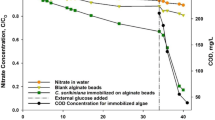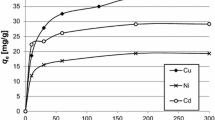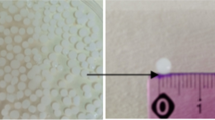Abstract
A great deal of research has been directed towards the problem of reduction of uranium concentration from few hundreds of ppb to less than 20 ppb, a limit of uranium in drinking water from ground water resources fixed in Dec, 2001 by US, Environmental Protection Agency. Laboratory simulated experiments were carried out for the reduction of U(VI) concentration in well water from few thousands of ppb to less than 20 ppb. Well water samples were spiked with U(IV) ranging from 1000 to 2000 ppb. The contaminated solutions were passed through a glass column containing of chlorella impregnated beads of calcium alginate. Chlorella(Chlorella pyrendoidosa), a fresh water algae, was immobilized in sodium alginate in the form of beads by using 0.2M calcium chloride solution. The solution was passed again through a charcoal solution to remove any trace of impurities. The concentration of uranium after treatment ranged from 10 to 20 ppb. The concentration of other major cations and anions in the solution were also monitored. This low cost kit was proposed for on-line removal of uranium from ground water used for drinking purposes. For taking care of waste disposal, 99-100% of the adsorbed uranium on beads was recovered by 0.1M HNO3. The desorption results suggest that the uptake of uranium by Chlorella is a physico-chemical adsorption on the cell surface, not a biological activity. The uranium in the algal cells is coupled to the ligand, which can be easily substituted with NO3 -.
Similar content being viewed by others
References
S. K. Sahota, H. Kaur, A. Kaur, H. S. Sahota, Nucl. Geophys., 9 (1995) 625.
Environmental Protection Agency Federal Registry: 40 CFR Parts 9, 141, and 142 [FRL-6909-3] RIN 2040-AC98 National Primary Drinking Water Regulations; Radionuclides; Final Rule Dec. 7, 2000.
P. Yong, L. E. Macaskie, J. Chem. Technol. Biotechnol., 71 (1988) 15.
M. L. Apel, A. E. Torma, Can. J. Chem. Eng., 71 (1993) 652.
A. Nakajima, T. Horikoshi, T. Sakaguchi, Agric. Biol. Chem., 43 (1979) 625.
T. Horikoshi, A. Nakajima, T. Sakaguchi, Agric. Biol. Chem., 43 (1979) 617.
R. H. Crist, J. R. Martin, J. M. Eslinger, D. R. Crist, Environ. Sci. Technol., 24 (1990) 337.
S. Schiewer, B. Volesky, Environ. Sci. Technol., 30 (1996) 2921.
Author information
Authors and Affiliations
Rights and permissions
About this article
Cite this article
Singhal, R.K., Joshi, S., Tirumalesh, K. et al. Reduction of uranium concentration in well water by Chlorella (Chlorella pyrendoidosa) a fresh water algae immobilized in calcium alginate. Journal of Radioanalytical and Nuclear Chemistry 261, 73–78 (2004). https://doi.org/10.1023/B:JRNC.0000030937.04903.c4
Issue Date:
DOI: https://doi.org/10.1023/B:JRNC.0000030937.04903.c4




